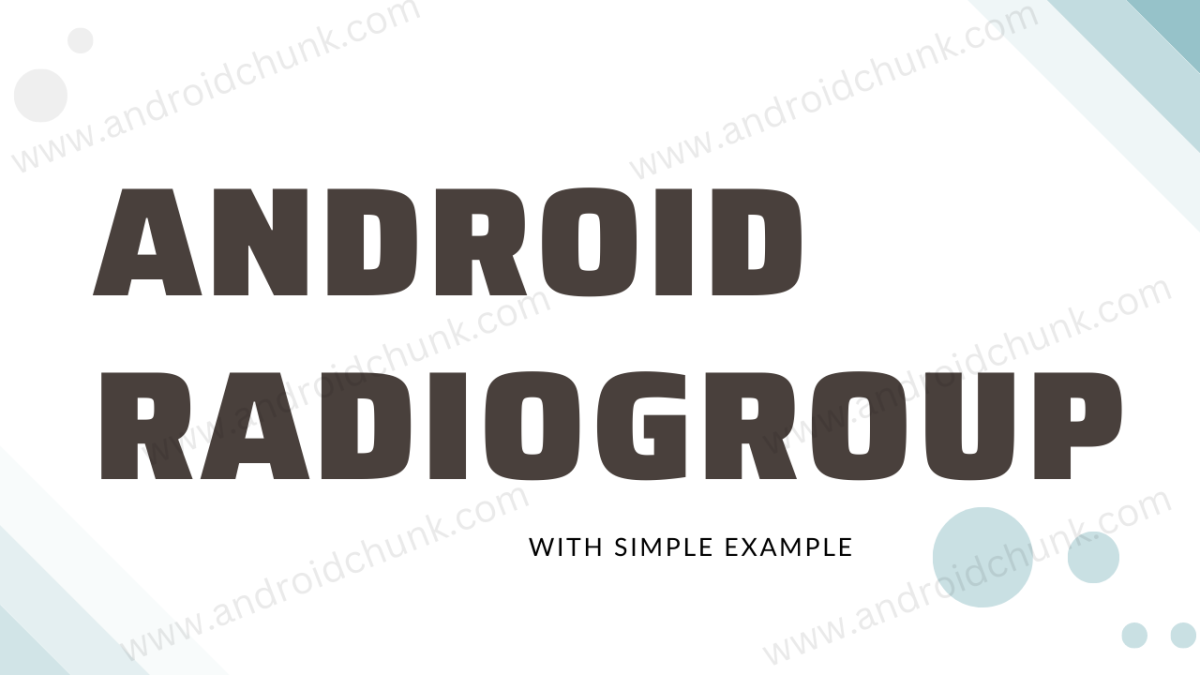21st February, 2023
Hello developers! We have learned earlier about Android Radio Button. Let’s take a quick look at Android RadioGroup.
1. What is RadioGroup?
In Android, RadioGroup is a widget used to group one or more radio buttons. If the user checks a radio button from a RadioGroup, the RadioGroup will automatically uncheck all other radio buttons. All radio buttons in a radio group are unchecked by default.
2. How to Create RadioGroup In Android?
2.1 Create RadioGroup in XML layout file
Just add a RadioGroup to the xml layout from the palette. Get reference of RadioGroup and perform operations based on the requirements.
<?xml version="1.0" encoding="utf-8"?>
<LinearLayout xmlns:android="http://schemas.android.com/apk/res/android"
xmlns:tools="http://schemas.android.com/tools"
android:layout_width="match_parent"
android:layout_height="match_parent"
android:orientation="vertical"
android:padding="10dp">
<!--Radio Group-->
<RadioGroup
android:id="@+id/radioGroup1"
android:layout_width="match_parent"
android:layout_height="wrap_content">
<!--Radio Button-->
<RadioButton
...
... />
<!--Radio Button-->
<RadioButton
...
... />
<!--Radio Button-->
<RadioButton
...
... />
<!--Radio Button-->
<RadioButton
...
... />
</RadioGroup>
</LinearLayout>
2.2 Create RadioGroup Programmatically in Android
In other ways, we can create a RadioGroup programmatically. We have to create an object of Android’s RadioGroup class. After that we can set attributes as required. We can add other views to it. See example below.
package com.androidchunk.radiogrouptest
import android.os.Bundle
import android.widget.RadioGroup
import androidx.appcompat.app.AppCompatActivity
class MainActivity : AppCompatActivity() {
override fun onCreate(savedInstanceState: Bundle?) {
super.onCreate(savedInstanceState)
setContentView(R.layout.activity_main)
//create a radio group
val radioGroup = RadioGroup(this@MainActivity)
//add radio buttons to the radio group
radioGroup.addView(radioButton1)
radioGroup.addView(radioButton2)
radioGroup.addView(radioButton3)
radioGroup.addView(radioButton4)
radioGroup.addView(radioButton5)
}
}
package com.androidchunk.radiogrouptest;
import android.os.Bundle;
import android.widget.RadioGroup;
import androidx.annotation.Nullable;
import androidx.appcompat.app.AppCompatActivity;
public class MainActivity extends AppCompatActivity {
@Override
protected void onCreate(@Nullable Bundle savedInstanceState) {
super.onCreate(savedInstanceState);
setContentView(R.layout.activity_main);
//create a radio group
RadioGroup radioGroup = new RadioGroup(MainActivity.this);
//add radio buttons to the radio group
radioGroup.addView(radioButton1);
radioGroup.addView(radioButton2);
radioGroup.addView(radioButton3);
radioGroup.addView(radioButton4);
radioGroup.addView(radioButton5);
}
}
3. Attributes of Android RadioGroup
| Attribute | Description |
|---|---|
| android:checkedButton | The id of the child radio button. The radio button should be checked. |
4. Simple Android RadioGroup Example
Hey, we have taken a simple example which explains how Android RadioGroup works. Ready?
Step 4.1: Create New Project
Create a new project in Android Studio from File ⇒ New Project and select Empty Activity from the templates.
Step 4.2: Enable View Binding
In this example we are using Android Jetpack’s feature view binding.
plugins {
id 'com.android.application'
id 'org.jetbrains.kotlin.android'
}
android {
...
...
buildFeatures {
viewBinding = true
}
...
...
}
dependencies {
...
...
...
}
Step 4.3: Add RadioGroup to the XML Layout (UI)
Add a RadioGroup to the xml layout from the palette. Add some radio buttons inside RadioGroup.
<?xml version="1.0" encoding="utf-8"?>
<LinearLayout xmlns:android="http://schemas.android.com/apk/res/android"
xmlns:tools="http://schemas.android.com/tools"
android:layout_width="match_parent"
android:layout_height="match_parent"
android:orientation="vertical"
android:padding="10dp"
tools:context=".MainActivity">
<TextView
android:layout_width="match_parent"
android:layout_height="wrap_content"
android:text="Which is the capital of Japan?"
android:textColor="@color/black"
android:textSize="18sp" />
<!--Radio Group-->
<RadioGroup
android:id="@+id/radioGroup1"
android:layout_width="match_parent"
android:layout_height="wrap_content">
<RadioButton
android:id="@+id/radioButton1"
android:layout_width="match_parent"
android:layout_height="wrap_content"
android:text="New York" />
<RadioButton
android:id="@+id/radioButton2"
android:layout_width="match_parent"
android:layout_height="wrap_content"
android:text="London" />
<RadioButton
android:id="@+id/radioButton3"
android:layout_width="match_parent"
android:layout_height="wrap_content"
android:text="Tokyo" />
<RadioButton
android:id="@+id/radioButton4"
android:layout_width="match_parent"
android:layout_height="wrap_content"
android:text="Dubai" />
</RadioGroup>
<LinearLayout
android:layout_width="match_parent"
android:layout_height="wrap_content"
android:layout_marginTop="15dp"
android:orientation="horizontal">
<Button
android:id="@+id/submitButton"
android:layout_width="0dp"
android:layout_height="wrap_content"
android:layout_marginEnd="15dp"
android:layout_weight="1"
android:backgroundTint="#7B1FA2"
android:text="SUBMIT" />
<Button
android:id="@+id/clearButton"
android:layout_width="0dp"
android:layout_height="wrap_content"
android:layout_marginStart="15dp"
android:layout_weight="1"
android:backgroundTint="#7B1FA2"
android:text="CLEAR" />
</LinearLayout>
</LinearLayout>
Step 4.4: Modify Activity
Open the relative activity and get RadioGroup reference. Add click listener for submit and clear buttons. Additionally we are using setOnCheckedChangeListener which will display a toast on click of any radio button.
package com.androidchunk.radiogrouptest
import android.os.Bundle
import android.view.View
import android.widget.RadioButton
import android.widget.Toast
import androidx.appcompat.app.AppCompatActivity
import com.androidchunk.radiogrouptest.databinding.ActivityMainBinding
class MainActivity : AppCompatActivity() {
//view binding
lateinit var binding: ActivityMainBinding
override fun onCreate(savedInstanceState: Bundle?) {
super.onCreate(savedInstanceState)
binding = ActivityMainBinding.inflate(layoutInflater)
setContentView(binding.root)
//the answer key
val answerKey = 2
//check change listener for the radio group
binding.radioGroup1.setOnCheckedChangeListener { radioGroup, checkedViewId ->
if (checkedViewId != View.NO_ID) {
val radioButton = findViewById<RadioButton>(checkedViewId)
if (radioButton.isChecked) {
Toast.makeText(this@MainActivity,radioButton.text.toString() + " selected",Toast.LENGTH_SHORT).show()
}
}
}
//handle click event of the submit button
binding.submitButton.setOnClickListener {
val checkedViewId = binding.radioGroup1.checkedRadioButtonId
if (checkedViewId != View.NO_ID) {
val selectedRadioButton: RadioButton =
findViewById(binding.radioGroup1.checkedRadioButtonId)
val indexOfSelectedRadioButton =
binding.radioGroup1.indexOfChild(selectedRadioButton)
if (indexOfSelectedRadioButton == answerKey) {
Toast.makeText(this@MainActivity, "You are correct!", Toast.LENGTH_SHORT).show()
} else {
Toast.makeText(this@MainActivity, "You are wrong!", Toast.LENGTH_SHORT).show()
}
} else {
Toast.makeText(this@MainActivity,"Please select an option first",Toast.LENGTH_SHORT).show()
}
}
//handle click event of the clear button
binding.clearButton.setOnClickListener(View.OnClickListener { binding.radioGroup1.clearCheck() })
}
}
package com.androidchunk.radiogrouptest;
import android.os.Bundle;
import android.view.View;
import android.widget.RadioButton;
import android.widget.RadioGroup;
import android.widget.Toast;
import androidx.annotation.Nullable;
import androidx.appcompat.app.AppCompatActivity;
import com.androidchunk.radiogrouptest.databinding.ActivityMainBinding;
public class MainActivity extends AppCompatActivity {
//view binding
ActivityMainBinding binding;
@Override
protected void onCreate(@Nullable Bundle savedInstanceState) {
super.onCreate(savedInstanceState);
binding = ActivityMainBinding.inflate(getLayoutInflater());
setContentView(binding.getRoot());
//the answer key
int answerKey = 2;
//check change listener for the radio group
binding.radioGroup1.setOnCheckedChangeListener(new RadioGroup.OnCheckedChangeListener() {
@Override
public void onCheckedChanged(RadioGroup radioGroup, int checkedViewId) {
if (checkedViewId != View.NO_ID) {
RadioButton radioButton = findViewById(checkedViewId);
if (radioButton.isChecked()) {
Toast.makeText(MainActivity.this, radioButton.getText() + " selected", Toast.LENGTH_SHORT).show();
}
}
}
});
//handle click event of the submit button
binding.submitButton.setOnClickListener(new View.OnClickListener() {
@Override
public void onClick(View view) {
int checkedViewId = binding.radioGroup1.getCheckedRadioButtonId();
if (checkedViewId != View.NO_ID) {
RadioButton selectedRadioButton = findViewById(binding.radioGroup1.getCheckedRadioButtonId());
int indexOfSelectedRadioButton = binding.radioGroup1.indexOfChild(selectedRadioButton);
if (indexOfSelectedRadioButton == answerKey) {
Toast.makeText(MainActivity.this, "You are correct!", Toast.LENGTH_SHORT).show();
} else {
Toast.makeText(MainActivity.this, "You are wrong!", Toast.LENGTH_SHORT).show();
}
} else {
Toast.makeText(MainActivity.this, "Please select an option first", Toast.LENGTH_SHORT).show();
}
}
});
//handle click event of the clear button
binding.clearButton.setOnClickListener(new View.OnClickListener() {
@Override
public void onClick(View view) {
binding.radioGroup1.clearCheck();
}
});
}
}
Step 4.5: Output
Happy coding!
